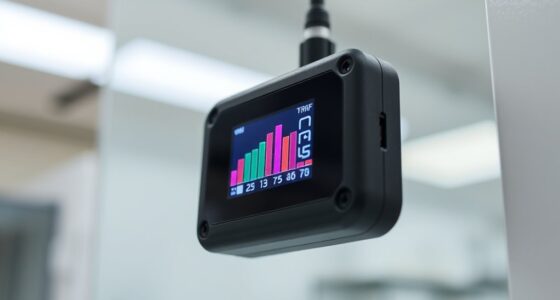The future of air quality tech involves advanced predictive sensors integrated into smart homes. These sensors detect pollutants in real-time and work with automation systems to activate purifiers or ventilation instantly, keeping your environment healthy. They also analyze data to forecast pollution spikes, helping you plan better and reduce exposure. As technology evolves, you’ll gain more control over indoor air quality, creating healthier living spaces. Keep exploring to discover how these innovations can transform your environment.
Key Takeaways
- Predictive sensors will enable real-time, proactive air quality management in smart homes, reducing exposure to pollutants.
- Integration with AI and machine learning will forecast pollution spikes, allowing preemptive actions.
- Smart home systems will automatically activate air purifiers and ventilation based on sensor data.
- Enhanced sensor networks will provide hyper-local, detailed pollution insights for better indoor and outdoor air quality control.
- Continued innovation will create smarter, healthier living environments with automated, anticipatory air quality solutions.

As concerns about air pollution continue to grow, advancements in air quality technology are shaping a cleaner, healthier future. One of the most exciting developments is sensor innovation, which is revolutionizing how we detect and respond to airborne pollutants. Gone are the days of relying solely on government monitoring stations that provide broad, often delayed data. Today, you can have real-time insights right at your fingertips. These small, highly sensitive sensors can be integrated into your home, providing instant feedback on pollutants like PM2.5, VOCs, carbon monoxide, and nitrogen dioxide. Their precision allows you to understand your environment better, empowering you to take immediate action to improve air quality.
Real-time, sensitive sensors empower you to monitor and improve your indoor air quality instantly.
Sensor innovation isn’t just about detecting pollutants; it’s about creating a proactive approach to air pollution. These sensors can be connected to smart home systems, forming an interconnected network that continuously monitors indoor and outdoor air. When poor air quality is detected, your system can automatically activate air purifiers, adjust ventilation, or even alert you to take personal precautions. This seamless integration helps you maintain a healthier living space without constant manual intervention. As sensor technology becomes more affordable and compact, you’ll find it easier to deploy multiple sensors across different rooms or outdoor areas, giving you a thorough view of your environment. This hyper-local data is crucial because air pollution levels can vary greatly depending on traffic, weather, and nearby sources of pollution. Moreover, integrating pollution data from these sensors with broader environmental information can enhance community-wide air quality management and policies.
The future of air quality tech also involves predictive capabilities powered by AI and machine learning. These systems analyze historical sensor data to forecast pollution spikes before they happen, allowing you to plan your activities accordingly. For example, if sensors detect rising pollutant levels predicted to peak during certain hours, you might choose to limit outdoor exercise or open windows earlier in the day. This proactive approach minimizes exposure and helps you protect your health. Smart homes equipped with these advanced sensors could also communicate with urban infrastructure, contributing to city-wide air quality management. Over time, this data can inform policies and improve pollution control measures, benefiting entire communities.
In essence, sensor innovation is transforming the way you interact with your environment. It’s no longer reactive; it’s about anticipating problems before they affect your health. As these technologies continue to evolve, expect smarter, more responsive homes that prioritize your well-being. With real-time data, predictive analytics, and seamless automation, you’ll have unprecedented control over your indoor air quality, making cleaner, healthier living a tangible reality.
Frequently Asked Questions
How Affordable Will Predictive Air Quality Sensors Become for Average Households?
You might wonder how affordable predictive air quality sensors will become for your household. As technology advances, manufacturers focus on cost reduction, making these sensors more accessible. While adoption barriers like high prices and complexity still exist, prices are expected to drop markedly over time. This means you’ll likely see more budget-friendly options soon, allowing you to improve your indoor air quality without breaking the bank.
What Privacy Concerns Arise With Smart Home Air Quality Monitoring Systems?
You should consider that smart home air quality monitoring systems raise privacy concerns, especially around data encryption and user consent. When these devices collect sensitive information about your environment, there’s a risk of data breaches if encryption isn’t strong. Additionally, you need to be aware of what you’re consenting to; some systems might share your data with third parties without clear permission. Staying informed helps protect your privacy.
Will These Technologies Be Accessible to People With Disabilities?
It’s a coincidence that as smart home air quality tech advances, so do efforts to improve accessibility. You’ll find that these technologies are increasingly designed with assistive technology in mind, reducing accessibility barriers. Developers aim to make sensors and systems usable for everyone, including people with disabilities. While challenges remain, the trend points toward more inclusive solutions, ensuring that all users benefit from healthier, smarter living environments.
How Do Predictive Sensors Differentiate Between Indoor and Outdoor Pollutants?
You might wonder how predictive sensors tell indoor pollutants from outdoor ones. They rely on sensor calibration to accurately detect specific pollutant levels. These sensors analyze data patterns and use algorithms to differentiate between indoor sources and outdoor air quality changes. This pollutant differentiation helps guarantee your home’s air quality stays safe, providing tailored alerts and responses based on what’s inside versus outside, making your smart home more effective and responsive.
What Standards Are Being Developed for the Interoperability of Air Quality Devices?
You should know that standards for air quality devices focus on device communication and data format standards to guarantee seamless integration. These standards help different devices, regardless of manufacturer, share accurate data efficiently. Developers are working on creating universal protocols that promote interoperability, so your smart home system can reliably interpret and respond to air quality data. This progress makes it easier for you to monitor and improve indoor air environments effectively.
Conclusion
As you embrace these new air quality technologies, remember that staying ahead of problems is key. Predictive sensors and smart homes put control in your hands, making it easier to breathe easier every day. Don’t wait until issues blow up; be proactive now. Think of this as your chance to get your house in order before small concerns turn into big headaches. The future’s bright if you’re willing to take the first step.









